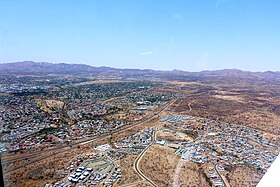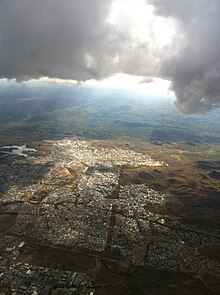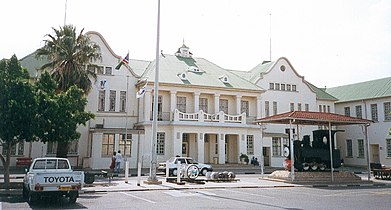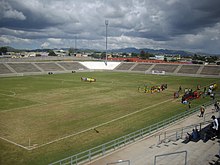Windhoek
| Municipality and city Windhoek Otjomuise ( her ) ǀAi-ǁGams ( naq ) |
|||
|---|---|---|---|
|
|||
| Aerial view of Windhoek with the Auas Mountains | |||
| motto | Suum cuique (each his own) | ||
| Basic data | |||
|
Population Area Population Density |
322,500 (2011) 5,133.40 km² 62.82 inhabitants / km² |
||
|
State Region Constituency |
Namibia Khomas 9 constituencies |
||
| Establishment date | October 18, 1890 | ||
|
License plate phone code |
W 061 |
||
| Website | www.windhoekcc.org.na | ||
|
Political data
Mayor : Fransina Kahungu ( SWAPO ) list Last election: 2015 Next election: 2020 City administration address: |
|||
|
Geographical data
Geographical coordinates : 22 ° 34′12 "S., 17 ° 5′1" E. |
|||
Windhoek [ 'vɪnthʊk ] ( ), German and from 1903 to 1918 officially Windhoek , is the capital of Namibia and the economic and political center of the country.
The city is located in the Windhoek Basin, the approximately geographical center of the country, bordered between the Eros Mountains in the east, the Auas Mountains in the south and the Khomashochland in the west and north. Windhoek was first mentioned in documents in 1840 and founded as a modern city in 1890. In 2011 it had 322,500 inhabitants, with an annual population growth of around 4.5 percent.
City names
The name Windhoek is Afrikaans and is derived from "Windecke" or "Windy corner"; the Khoekhoegowab name ǀAe-ǁGams means something like "hot spring", which indicates the region's former thermal springs . The city's Otjiherero name, Otjomuise , also means “place of steam”. Other former names of the city are Queen Adelaide's Bath (by Sir James Edward Alexander ), Barmen (by Carl Hugo Hahn of the Rhenish Mission Society ), Concordiaville (according to Joseph Tindall of the Wesleyan Mission ) and Wind Hoock ( Jan Jonker Afrikaner ).
At the beginning of the German colonial era, the spellings Windhoek and Windhoek were equally common for the city . The government order issued by Theodor Leutwein with effect from May 14, 1903 determined the city of Windhoek to be the only official name . In 1918 the official city name was changed to Windhoek , while German remained an official language of the country. In German usage outside of Namibia, the spelling Windhoek is still used. It is the official spelling of the Federal Foreign Office .
geography
The Windhoek Basin (English Windhoek basin ) is a partially hilly valley basin within the Khomashochland , which in turn belongs to the Great Peripheral Step . The Windhoek Basin is between 1625 m and 1725 m in height and rises up to 1800 m on some of its edges . It is surrounded on all sides by mountain ranges that only partially open in the north, such as along the Klein-Windhoek- Rivier towards Brakwater . The Erosberge in the east and the Auasberge in the south of the city each form a ridge line at an altitude of around 2000 m ; other prominent elevations are the Nubuamisberg in the north and the Grossherzog-Friedrich-Berg in the southwest of the city. This topography represents a natural limitation for further urban development, as the flat building plots necessary for industry and sports facilities have become rare and the recently built residential areas are already approaching steeper mountain slopes.
The Klein-Windhoek-Rivier, which is dammed in its upper reaches by the Avis dam , crosses the eastern urban area from south to north. The south-west of the city is crossed by the Gommans and Arebbusch-Rivier rivers, both of which feed the Goreangab reservoir in the north-west of the city. To the west of Windhoek is the 40 km² Daan Viljoen Wildlife Park .
climate
Like much of Namibia, Windhoek has an arid climate . Mainly because of the winds that give Windhoek its name, this climate is perceived as pleasant, especially during the winter months from April to September.
The 2010/11 rainy season was the wettest in the 120-year history of Namibian climate records, with precipitation exceeding 1100 millimeters in places.
|
Average monthly temperatures and rainfall for Windhoek
Source: Weather-Atlas.com
|
|||||||||||||||||||||||||||||||||||||||||||||||||||||||||||||||||||||||||||||||||||||||||||||||||||||||||||||||||||||||||||||||||||||||||||||||||||||||||||||||||||||
history
The area around Windhoek was already inhabited by the San several thousand years ago.
The hot springs in the Windhoek region were the reason for an Orlam settlement under Jonker Afrikaner around the middle of the 19th century , roughly on the site of what is now the Klein-Windhoek district .
During the following years, the Boers , Dutch settlers from the Cape Colony , built a stone church that could hold up to 500 people and was also used as a school. At this time, Carl Hugo Hahn and Franz Heinrich Kleinschmidt from the Rheinische Missionsgesellschaft were also active as missionaries in Windhoek. The young city gradually began to flourish, but was destroyed as a result of armed conflict between the Nama and the Herero . When Hugo Hahn decided in 1873 to visit Windhoek again after a long absence, he found that nothing was left of the once thriving city. A Swiss botanist noted in June 1885 that in Windhoek he had found "nothing but jackals and frightened guinea fowl between neglected fruit trees".
1878, the annexed United Kingdom which lies along the coast Walvis Bay , including Penguin Islands and incorporated this in 1884 the Cape Colony one, however, was not interested in the hinterland. Due to the work of the Rheinische Missionsgesellschaft practiced since the early 19th century and larger land acquisitions by Adolf Lüderitz , German South West Africa was proclaimed a so-called German “protected area” in 1884 . Otjimbingwe was first chosen as the administrative seat of the colony , but in 1891 Curt von François , then captain of the protection force , decided to build the more centrally located Windhoek as the new administrative center. At that time Windhoek was also considered a strategic buffer zone between the warring Nama and Herero, and its springs also ensured the water supply for the new capital.


On October 18, 1890, Curt von François laid the foundation stone for the modern city of Windhoek with the start of construction of a stone fortress, today's Alte Feste . During the following years, Windhoek developed slowly and only the most necessary administrative and residential buildings were built. From the beginning of its history, Windhoek was also marked by the separation of the white and black populations; In Klein-Windhoek, for example, farmland was given to white settlers who set up small fruit and tobacco plantations in the area. Also in Klein-Windhoek - as well as today's Hochland Park - land was given to the local population, who built their traditional settlements (the so-called shipyards ) here. By 1913, all of Windhoek's local residents were forcibly relocated to three of these wharfs. With the increasing influx of the rural population and increased immigration, mainly from the German Empire and South Africa, the population grew to around 11,000 by 1916. Numerous shops and companies set up shop along what was then Kaiserstraße (today's Independence Avenue ). During this time, the three “Windhoeker Stadt-Burgen” designed by Windhoek architect Wilhelm Sander , namely the Schwerinsburg , the Heinitzburg and the Sanderburg, were built .
The German colonial era ended in Windhoek during the First World War in May 1915 when South African troops under the British flag took and occupied the city. For the next five years, South West Africa was administered by a military government and, since 1921, by the mandate administration. At the beginning of the 1930s, the black suburbs experienced further segregation into the individual tribes. The German population split into politically extreme groups (DSWB and DAP ) and became politically insignificant in the post-war period. Only as a result of the global economic crisis and again after 1955 were numerous large-scale projects implemented by the public sector, such as the asphalting of the roads (which began in 1928) and the construction of dams and pipelines to meet the growing demand for water. A number of new schools and hospitals also sprang up, strictly segregated . Many of these projects were realized by recruited workers from Ovamboland , with politicians and town planners at that time again planning to relocate the local population. After consultation with the Mandate Administration for South West Africa and the South African government, but without consultation with the local population, it was decided to create new suburbs in the northwest of the city and to relocate all black residents from their residential areas again.
At that time, the black population identified with their district and refused to evacuate their homes. As a result, there were first demonstrations in December 1959 and then a boycott in the former Alte Werft ( Old location , in what is now the Hochland Park district), the largest residential area for the locals. The South African police then occupied the district, after which there was unrest on December 10, 1959, in which the police shot eleven people and around 50 people were injured, some seriously. This already tense situation came to a head when Governor Daniel Thomas du Plessis Viljoen ordered that medical aid should not be given to any of the injured insurgents. Although black pastors called on the Rhenish Mission to at least formally protest against the killing of demonstrators, the latter looked on inactive; the Southwest African Red Cross did not allow blood to be donated to the wounded after the injunction.
These events, which went down in history as the uprising at the Alte Werft ( Old location uprising ), were a turning point in the history of Namibia . Many leaders such as Sam Nujoma , Moses Makue ǁGaroëb , Uatja Kaukuetu, Nathan Mbaeva, Zedekia Ngavirue, Clemence Kapuuo, David Meroro, John Ya Otto and Emil Appolus were involved in them. The events were a main reason for the will of the population for liberation from foreign rule and independence of the country. Samuel Nujoma was arrested as a result of the uprising and later forced into exile. In the course of 1960 the SWAPO was founded .
Immediately after the uprising, between three and four thousand residents left their homes for fear of further police riots. Established structures in the social life of the district were destroyed until it was finally closed in 1968. The new suburb in the northwest of Windhoek was called Katutura , which translates as: the place where you don't live . In 1961 and 1963, the smaller shipyards in the Klein Windhoek and Pokkiesdraai districts were closed and the government's apartheid policy continued unabated. Khomasdal was only intended for colored people , and Katutura was further subdivided into sectors with precise division and separation of the individual tribes. By the late 1980s, all government buildings and many private businesses and businesses were given separate entrances for different ethnic groups.
With Namibia's independence from South Africa in 1990, Windhoek became the capital of the first democratically elected government under Sam Nujoma, and the new mayor of the city was the German-Namibian Björn von Finckenstein . The independence of the country not only led to the elimination of the apartheid structures, but also gave the city a new impetus and enormous population growth rates, which further stimulated its development. Acting Mayor of the City of Windhoek is Fransina Kahungu in December 2019 .
Population development
The Mayor of Windhoek expected in 2009 that the population will reach one million by 2030.
In 2011 the census found 322,500 inhabitants, with an increase of around 4% to 5% per year in recent years.
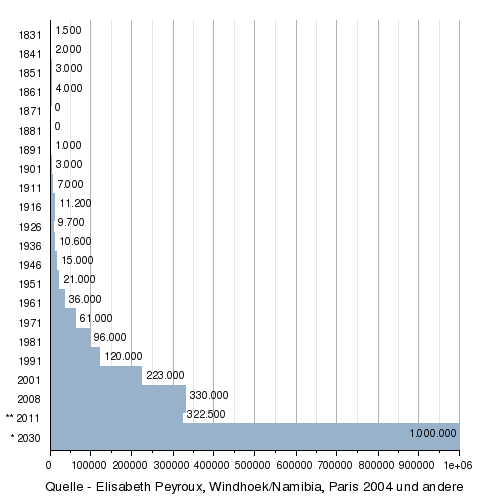
Politics and administration
As the capital of Namibia, Windhoek is the seat of the Namibian government . The government buildings include the Parliament of Namibia , consisting of the National Council and National Assembly , several ministries , numerous government organizations and the Supreme Court . The more than 50 embassies and consulates in Windhoek also include the German Embassy Windhoek as well as the Consulate General of Switzerland and the Honorary Consulate of Austria .
The city of Windhoek is governed by the city administration and a city council consisting of 15 members. They include the city council chairperson and the mayor.
Expansion of the urban area
In 2012, the Ministry of Housing and Rural Development made the decision to expand the Windhoek urban area on private farmland by around 50 kilometers in each direction, i.e. around 4500 square kilometers. This decision initially met with massive opposition from the city administration and the owners of the land. The area of the city after the expansion is 5,133.4 km². Previously, the urban area was 715.8 km². The population density thus fell from 455.6 inhabitants per square kilometer to 62.82.
City districts and districts
Windhoek consists of the city center Central as well as more than 30 districts or districts (without expansion in 2012):
- Windhoek Academia
- Windhoek-Auasblick
- Windhoek advice
- Windhoek-Cimbebasia
- Windhoek-Dorado Park
- Windhoek Eros
- Windhoek Eros Park
- Windhoek-Gore stated
- Windhoek Hakahana
- Windhoek Highlands Park
- Lafrenz industrial area
- Windhoek Katutura
- Windhoek-Khomasdal
- Little Windhoek
- Windhoek-Kleine Kuppe
- Windhoek-Ludwigsdorf
- Windhoek luxury hill
- Windhoek North
- Northern industrial area
- Windhoek-Okuryangava (including Okahandja Park, Ongulumbashe, Babilon and Kilimanjaro)
- Windhoek Olympia
- Windhoek- Otjomuise
- Windhoek Pioneer Park
- Windhoek Prosperita
- Windhoek Rocky Crest
- Southern industrial area
- Windhoek-Suiderhof
- University of Namibia
- Windhoek-Wanaheda
- Windhoek West
- north of 8 adjacent to 9 Windhoek-Havana (also called Big Bend )
- between 10 and 25 Windhoek pigeons Glen
On April 15, 2011, the city administration announced that in the future Omeya , a golf course under construction 30 kilometers to the south, with tourist infrastructure such as hotels and adjacent residential areas for workers, will be integrated into the city of Windhoek. Thus Windhoek would grow by around 254 hectares.
In addition, the urban area is divided into ten constituencies of the capital region Khomas , each of which is headed by a Councilor (council member) and which, under Regional Council Chairman Sophia Shaningwa, form the Regional Council Khomas Regional Council .
In addition to the nationwide Namibian Police , the Windhoek City Police also take care of security in the city . The city-owned company Windhoek Bus Service handles local public transport .
City budget
The public budget of the city of Windhoek and its administrative area is determined annually by the City Council of Windhoek . In the financial year 2010/11, the asset budget amounted to 344.8 million Namibian dollars (N $), the administrative budget N $ 1682 million. An annual deficit of six million Namibian dollars was expected.
Local government
The following official final result was determined in the 2015 local elections .
| Political party | be right | Share of votes | Seats |
|---|---|---|---|
| SWAPO | 37,533 | 77.4% | 12 |
| DTA | 4171 | 8.6% | 1 |
| NUDO | 1453 | 2.9% | 1 |
| RDP | 1422 | 2.9% | 1 |
| UDF | 1294 | 2.7% | 0 |
| RP | 849 | 1.8% | 0 |
| APP | 807 | 1.7% | 0 |
| SWANU | 516 | 1.06% | 0 |
| CDVP | 217 | 0.5% | 0 |
| WRP | 199 | 0.4% | 0 |
| total | 48,461 | 100% | 15th |
Economy and Transport
→ See also: Namibian economy

With around 20% of Namibia's total population, Windhoek is by far the country's most important economic center. Almost all Namibian or Namibian-based companies have their headquarters in Windhoek, which also results in sustained immigration from other parts of the country, which in turn underpins Windhoek's central position. In addition to the Bank of Namibia , the large state supply companies and numerous service companies in the tourism industry , Windhoek is also an important trade fair location (including the Windhoek Show and Namibia Tourism Expo ) and a center for the manufacturing industry. In addition to the national broadcasting company NBC , the editorial offices of the three largest daily newspapers in Namibia ( Namibian , Republikein and AZ ) are also based in Windhoek. The city has nationally as one of the main hubs for Karakul -Felle.
Despite the numerically very small proportion of the total population, many companies are owned by German-Namibian owners; this with an extremely unequal distribution of income in a global comparison . South African companies , which for historical reasons are closely linked to the Namibian economy , also play an important role .
Due to its central geographic location and its outstanding economic position, Windhoek is the main traffic junction of the Namibian road, rail and aviation networks.
The two most important road connections cross in Windhoek: the national road B1 from Cape Town / South Africa to Luanda / Angola, which runs in north-south direction, and the Trans-Kalahari Highway ( B2 and B6 ), which runs in east-west direction, from the Atlantic to India Ocean . Thanks to the “Western Bypass”, which has been developed like a motorway and bypasses Windhoek in a semi-arc as an expressway, the city center is largely spared from through traffic.
TransNamib railway lines from Gobabis (in the east), Keetmanshoop (in the south), Swakopmund (in the west) and Tsumeb (in the north) also come together here. The Namibian rail transport plays an important role, especially in freight transport. In addition, the Desert Express, recently advertised by tourism, runs regularly on the Windhoek-Swakopmund route. Lüderitz or Tsumeb / Etosha National Park are also approached at irregular intervals . Otherwise, passenger traffic takes place primarily on the road, either as individual traffic or as overland bus traffic to destinations in Inner-Namibia, South Africa and Botswana .
Windhoek has two airports : The domestic airport " Airport Windhoek-Eros " located on the southern outskirts of the city and the International Airport Windhoek "Hosea Kutako" located about 40 kilometers east of the city . From here, among others, the state-owned airline Air Namibia and South African Airways serve almost all domestic Namibian and a large number of domestic African destinations. Air Namibia also flies intercontinentally to Frankfurt six to seven times a week, and Air Berlin flew to Munich once or twice a week until the end of October 2012 .
Due to an ongoing drought , Windhoek has had an unsafe water supply since the beginning of 2016 . Savings of at least 40 percent were recommended in order to be able to provide drinking water by the coming rainy season. In the medium term, a canal from the Okavango or a pipeline from the Atlantic with a connected seawater desalination plant are planned.
Arts and Culture

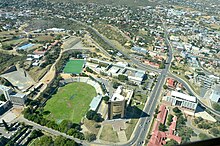
For decades, Windhoek was considered the cleanest capital in Africa (but gave the title to Kigali in 2015 ). In a ranking of cities according to their quality of life, Windhoek took 130th place out of 231 cities worldwide in 2018.
Due to its social security and the coexistence of the Namibian ethnic groups, the city is considered an exemplary social model for a large African city, but it also looks quite tranquil.
In the streetscape of the city center, small street cafes and beer gardens convey the character of a Central European city, with a building fabric that - along with many modern buildings - is shaped by Wilhelmine colonial architecture from the turn of the century. Important sights are the colonial buildings on Independence Avenue , St. Mary's Cathedral (1908), Christ Church (1911) and the Ink Palace as well as the Old Fortress . Since independence, numerous buildings based on African architecture have been built, such as the new Supreme Court (1990).
Windhoek's museums and galleries offer exhibitions on the country's cultural and geological history, as well as traditional and contemporary art; in particular the National Museum , the TransNamib Museum , the National Geoscientific Museum and the Independence Memorial Museum and the National Gallery . Street vendors selling small handicrafts are also typical of Windhoek. The National Library of Namibia is the central archive library and national bibliographic center of Namibia.
Performing arts are cultivated in the National Theater and the private Warehouse Theater , on the other hand - since the relocation of the Windhoeker Brewery to the outskirts of the city - the "Old Brewery" (1902) in the center has become the focus of craftsmanship.
The increasing self-confidence of the black majority of the population and the growing interest of tourists in black African culture led to an increase in public awareness of “ black African ” culture. How to organize:
- the Wild Cinema Windhoek International Film Festival in March (since 2002 taking place at various locations forming international Film Festival )
- the Windhoek Carnival (WIKA) in April (a tourist attraction since the 1950s, which in the first years of independence was limited to a rather "closed" event and was often only noticed by other ethnic groups, but has recently become one more open event established)
- the Namibia Travel Expo in May
- the Standard Bank Biennale (Namibia's largest art fair since 1981. The Standard Bank Biennale only takes place every other year and there are currently plans to continue it through the Bank Windhoek Triennale )
- the ǀAeǀGams Arts and Cultural Festival (art and culture festival organized by the city since 2001)
- the cultural weeks of the Technical University and University in August and September
- the Windhoeker Oktoberfest
- the Namibia Youth Expo in October (international contact fair for young start-up entrepreneurs and artists, supported by social awareness organizations, to get to know possible sponsors or business partners) and
- the Sanlam NBC Music Awards in December (in addition to the Namibian Music Awards in Ongwediva , since 2002 taking place Music Prize of the NBC with competitions in the categories Hip-Hop / African Hip Hop , House , Kwaito , Reggae , R & B / Afro-pop , rock ' n 'Roll and various traditional music styles including German-speaking folk music .)
religion
With the exception of the Evangelical Lutheran Church in Namibia (ELCIN) based in Oniipa , Windhoek is the seat of all major churches in Namibia : most of the city's residents are members of the Evangelical Lutheran Church in the Republic of Namibia (ELCRN) or the Roman Catholic Church in Namibia . Smaller congregations are the German-speaking German Evangelical Lutheran Church in Namibia (ELKIN-DELK), the Anglican Church of Southern Africa and the United Congregational Church of Southern Africa. A list of resident church buildings is available under List of Churches in Windhoek .
Significant church buildings are the Protestant Christ Church , the seat of the ELKIN-DELK bishopric, and the Catholic St. Mary's Cathedral , the main church of the Archdiocese of Windhoek .
Attractions
The city's landmarks are the Alte Feste , which houses the National Museum of Namibia , and the Lutheran Christ Church, completed in 1910 . The equestrian monument , which is also part of the ensemble , was lifted from its base in front of the old fortress on December 25, 2013 using a crane and moved into the fortress. The base was destroyed. The Independence Memorial Museum is located next to the old fortress .
Other major attractions in Windhoek include:
- the Roman Catholic St. Mary's Cathedral Windhoek , built in 1908
- the gymnasium, location where the gymnasium constituent conference was held in the 1970s
- Die Alte Brauerei (Old Brewery) , former premises of the Namibia Breweries
- the ink palace as well
- the three city castles Heinitzburg , Schwerinsburg and Sanderburg
Also worth seeing are the Tukondjeni Market (Tukondjeni Markt) or the Penduka Project Center in the more densely populated districts of Katutura and Khomasdal . Outside the city is the National Heroes' Field .
Windhoek station with the TransNamib Museum
" Ink Palace ", seat of the Parliament of Namibia
Zoo Park , popular meeting place and event location
Catholic St. Mary's Cathedral
Lutheran Christ Church
Südwester Reiter , officially called "Reiterdenkmal", before moving to the Alte Feste
Education and sport
Since independence, Windhoek has gradually developed into an education and research location, especially in the areas of social sciences and environmental sciences / research. The University of Namibia, founded in 1992, now has over 10,000 students and together with the International University of Management , the Namibia University of Science and Technology and other universities, the number of students in Windhoek amounts to over 30,000. There are also numerous national and international research institutes in Windhoek: including the Namibia Scientific Society , the Foundation for Desert Research in Namibia , the National Botanical Research Institute , the Labor Resource and Research Institute , the Namibia Nature Foundation , the Namibia Economic Policy Research Unit and a department of the Max Planck Institute for Astronomy ( HESS ).
School education in Namibia is supported by government organizations such as the National Institute for Educational Development and non-governmental organizations such as EduVentures in projects such as the Bernard Nordkamp (BNC) and the Katutura Community Arts Center (KCAC). The Namibian average illiteracy rate is still 16.2% (7.7% of 15 to 24 year-olds, with a lower percentage for the urban population). International schools in Windhoek are the International School Windhoek and the Deutsche Höhere Privatschule Windhoek .
Many of the sporting facilities of Windhoek are located in the southern districts of Olympia and Kleine Kuppe (such as the Independence Stadium (Namibia) of the Namibian national soccer team and the Hage Geingob Stadium of the Namibian National Rugby Union team ) as well as in the northwestern districts of Katutura and Khomasdal ( like the Sam Nujoma Stadium ).
Football is a national sport in Namibia, and seven of the twelve football clubs in the Namibia Premier League are from Windhoek. The largest sports club in Windhoek is the SK Windhoek with over 900 members.
Town twinning
The city of Windhoek has (as of February 2019) entered into 17 city partnerships.
|
|
Other partnerships (no official city partnerships)
|
Domestic agreements
|
Source: City of Windhoek
Personalities
sons and daughters of the town
- Rolf von Goth (1906–1981), German actor and radio play director
- Ursula Vogel-Weidemann (1930–1997), German-South African ancient historian
- Nora Schimming-Chase (1940–2018), politician and civil rights activist
- Jerry Ekandjo (* 1947), SWAPO politician
- André du Pisani (* 1949), political scientist
- Utoni Nujoma (* 1952), politician and Minister for Land Reform since 2015
- Giselher W. Hoffmann (1958-2016), writer
- Obeth Kandjoze (* 1966), SWAPO politician
- Frank Fredericks (* 1967), track and field athlete and Olympic participant
- Juanita du Plessis (* 1972), singer
- Nannie de Villiers (* 1976), former South African tennis player
- Collin Benjamin (* 1978), football player
- Muesee Kazapua (* 1980), SWAPO politician and Mayor of Windhoek from 2014 to 2019
- Oliver Risser (* 1980), German-Namibian soccer player
- Gaby Ahrens (* 1981), marksman and Olympic participant
- Erik Hoffmann (* 1981), German-Namibian racing cyclist and Olympic participant
- Wilko Risser (* 1982), German-Namibian soccer player
- Beate Baumgartner (* 1983), Austrian-Namibian singer
- Eric Sell (also ees-y EES or EES; * 1983), musician
- Julius Indongo (* 1983), professional light welterweight boxer and former world champion
- Leonie von Hase (* 1985), German beauty queen
- Sedekia Haukambe (* 1985), football player
- Michael Lerchl (* 1986), soccer player
- Manfred Starke (* 1991), German-Namibian soccer player
- Costa Seibeb (1992-2017), racing cyclist
- Vera Adrian (* 1993), cyclist
- Till Drobisch (* 1993), racing cyclist
- Sandra Starke (* 1993), German-Namibian soccer player
- Neville Tjiueza (born 1993), football player
Personalities associated with the city
- Gustav Voigts (1866–1934), one of the first German farmers in what was then the German protected area of German South West Africa and mayor of Windhoek
- John Meinert (1886–1946), German-Namibian businessman and 1929–38 mayor of Windhoek
- Adolph Jentsch (1888–1977), Namibian landscape painter of German descent
- Abraham Bernard May (1912–1993), South African-Namibian surgeon and Mayor of Windhoek
- Ernst Guenter Erich Kaschik (1932–2000), economist and politician, a. a. Mayor of Windhoek (1974-76)
- Bonifatius Hausiku (1933 / 35–2002), priest and first archbishop of Windhoek and first black Catholic bishop of Namibia
- Klaus Dierks (1936–2005), one of the most important traffic planners and engineers in Namibia
- Matheus Shikongo (* 1950), politician and former mayor of Windhoek
- Anton Lubowski (1952–1989), German Namibian lawyer and activist and Secretary General of SWAPO
- Björn von Finckenstein (* 1958), German Namibian doctor and politician, member of the city council and former mayor of Windhoek
- Barbara Kahatjipara (* 1975), international photo model
literature
- Sabine Aquilini et al .: Mainly Windhoek . Wordweaver Publishing House, Windhoek 2013, ISBN 978-99916-889-1-6 .
- Conny von Dewitz: Windhoek. The little city guide . Kuiseb-Verlag, Windhoek 2009, ISBN 978-3-941602-17-5 .
- Rolf Brockmann: Katutura: Forays through Windhoek's township . Klaus Hess, Göttingen 2006, ISBN 978-3-933117-04-5 .
annotation
- ↑ Note: This article contains characters from the alphabet of the Khoisan languages spoken in southern Africa . The display contains characters of the click letters ǀ , ǁ , ǂ and ǃ . For more information on the pronunciation of long or nasal vowels or certain clicks , see e.g. B. under Khoekhoegowab .
Web links
- Official website of the City of Windhoek (English)
Individual evidence
- ↑ Windhoek - Der kleine Stadtführer, Conny von Dewitz, 2009, ISBN 978-3-941602-17-5
- ^ German Embassy Windhoek ( Memento from June 14, 2007 in the Internet Archive ), accessed on November 7, 2012
- ↑ Beste reënjaar nóg in dekades, Die Republikein, March 16, 2011 ( Memento from February 17, 2013 in the Internet Archive )
- ↑ Weather-Atlas.com. Retrieved July 27, 2020.
- ↑ a b Klaus Dierks : Prehistoric Time Chronology of Namibian History January 2, 2005, accessed on March 10, 2009; private website
- ^ History. Archived from the original on February 21, 2010 ; accessed on September 1, 2015 .
- ↑ Allgemeine Zeitung of November 13, 2008: Population of Windhoek .
- ↑ Vision Paper Namibia, Outlook 2030, Chapter 4, ( Memento of March 12, 2011 in the Internet Archive ) National Planning Commission , 2009
- ^ Namibia 2011 Population and Housing Census Preliminery Results. Namibia Statistics Agency, April 2012, accessed May 9, 2012
- ↑ FARMERS PANIC OVER WINDHOEK EXTENSION. Windhoek Observer, November 2, 2012 ( memento of February 21, 2015 in the Internet Archive ). Retrieved January 13, 2013
- ↑ Windhoek is growing: For the first time, concrete details on urban expansion (1/2). Allgemeine Zeitung, July 3, 2013 Retrieved July 3, 2013
- ↑ Omeya integrated into the City of Windhoek boundaries, Press Notice Omeya, April 15, 2011 ( Memento of May 17, 2011 in the Internet Archive )
- ^ Khomas Regional Council. Archived from the original on September 21, 2007 ; accessed on September 1, 2015 .
- ↑ A question of time - electricity in Windhoek is getting more expensive, but nobody knows when, Allgemeine Zeitung, July 2nd, 2010
- ↑ Official election results of the regional and local elections 2015, ECN, December 4, 2015 ( Memento of December 10, 2015 in the Internet Archive ) (PDF; 150 kB)
- ↑ Welcome to the Desert Express website ( Memento from April 28, 2006 in the Internet Archive )
- ↑ Windhoek is getting dirtier and transfers the “clean title” to Kigali. General newspaper, October 21, 2015
- ↑ Mercer's 2018 Quality of Living Rankings. Retrieved August 18, 2018 .
- ^ Namibia: Windhoek, City Profile. Archived from the original on October 2, 2009 ; accessed on September 1, 2015 .
- ↑ Real Namibia: Windhoek. Archived from the original on November 21, 2012 ; accessed on September 1, 2015 .
- ↑ VIRTUAL TOUR THROUGH THE SUPREME COURT. Archived from the original on December 18, 2012 ; accessed on September 1, 2015 .
- ^ Museum. Retrieved September 1, 2015 .
- ↑ Wild Cinema Windhoek International Film Festival .
- ↑ Allgemeine Zeitung of April 7, 2008 ( Memento of August 21, 2008 in the Internet Archive ).
- ^ National Youth Council of Namibia. Retrieved September 1, 2015 .
- ↑ Events in Windhoek throughout the year. Retrieved September 1, 2015 .
- ^ Windhoek city tours. Retrieved September 1, 2015 .
- ^ John Aitchison and Peter Rule: A quick survey of SADC literacy statistics and projections , 2005, UNESCO Doc. 2006 / ED / EFA / MRT / PI / 5, p. 53 (Status: 2000/2001; PDF; 3.39 MB).
- ↑ Did you know? Aloe, Issue 1, September 2012, p. 5
- ↑ Official website of the partnership ( Memento from September 5, 2008 in the Internet Archive )
- ↑ Municipality and Drakenstein sign MoU The Namibian, May 10, 2012, p. 13
- ^ Jamaican capital city agrees to twin with Windhoek. Namibia Press Agency, January 11, 2018.
- ↑ Two twin cities for Windhoek. Allgemeine Zeitung, July 31, 2018.
- ^ New partnership , Allgemeine Zeitung, July 29, 2011
- ^ City of Windhoek signed friendly cooperations with the Municipality of Chongqing. Aloe, September 2013, issue 12, p. 1
- ↑ THE CITY OF WINDHOEK SIGNS A FRIENDSHIP CITY AGREEMENT WITH THE CITY OF SUZHOU. City of Windhoek, September 3, 2019.
- ↑ a b New twin cities ( Memento from February 1, 2012 in the Internet Archive )
- ↑ Katima Mulilo and Windhoek city sign agreement. Namibia Press Agency, 23 August 2017.
- ^ Windhoek, Nkurenkuru in twinning agreement. New Era, September 20, 2013. Retrieved October 16, 2013
- ↑ a b c City of Windhoek inked MoU with Opuwo, Otavi and Usakos. Aloe Newsletter, City of Windhoek, Issue 7, April 2013
- ↑ International Relations. (PDF) Archived from the original on February 16, 2012 ; accessed on September 1, 2015 .
Coordinates: 22 ° 34 ′ S , 17 ° 5 ′ E


